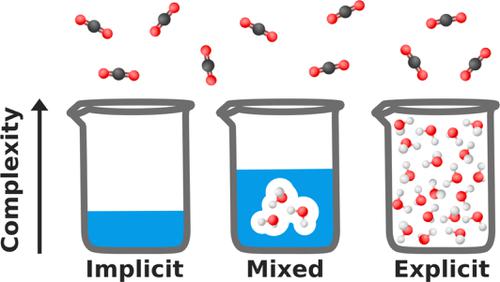当前位置:
X-MOL 学术
›
WIREs Comput. Mol. Sci.
›
论文详情
Our official English website, www.x-mol.net, welcomes your feedback! (Note: you will need to create a separate account there.)
Advances and challenges in modeling solvated reaction mechanisms for renewable fuels and chemicals
Wiley Interdisciplinary Reviews: Computational Molecular Science ( IF 11.4 ) Pub Date : 2019-10-17 , DOI: 10.1002/wcms.1446 Yasemin Basdogan 1 , Alex M. Maldonado 1 , John A. Keith 1
Wiley Interdisciplinary Reviews: Computational Molecular Science ( IF 11.4 ) Pub Date : 2019-10-17 , DOI: 10.1002/wcms.1446 Yasemin Basdogan 1 , Alex M. Maldonado 1 , John A. Keith 1
Affiliation

|
We provide a critical overview of progress and challenges in computationally modeling multistep reaction mechanisms relevant for catalysis and electrocatalysis. We first discuss how the chemical and materials space of energetically efficient catalysis can be explored with computational chemistry. Since reactions for renewable energy catalysis can involve acid–base chemistry and/or ions under aqueous conditions, we then summarize how solvation can be modeled with quantum chemistry schemes using implicit, mixed implicit/explicit, and fully explicit solvation modeling. We will discuss the insights (and limitations) of these solvation models primarily through the scope of understanding CO2 reduction reaction mechanisms, but these will also be applicable for future work elucidating other reaction mechanisms of critical importance for human sustainability such as H2O oxidation and N2 reduction.
中文翻译:

在建模可再生燃料和化学溶剂化反应机理方面的进展和挑战
我们提供了对与催化和电催化相关的多步反应机理进行计算建模的进展和挑战的重要概述。我们首先讨论如何利用计算化学来探索能效催化的化学和材料空间。由于可再生能源催化的反应可能涉及在水性条件下的酸碱化学和/或离子,因此我们总结了如何使用隐式,混合隐式/显式和完全显式溶剂化模型通过量子化学方案对溶剂化进行建模。我们将主要通过了解CO 2的范围来讨论这些溶剂化模型的见解(和局限性)。还原反应机理,但是这些也将适用于将来的工作,阐明对人类可持续性至关重要的其他反应机理,例如H 2 O氧化和N 2还原。
更新日期:2019-10-17
中文翻译:

在建模可再生燃料和化学溶剂化反应机理方面的进展和挑战
我们提供了对与催化和电催化相关的多步反应机理进行计算建模的进展和挑战的重要概述。我们首先讨论如何利用计算化学来探索能效催化的化学和材料空间。由于可再生能源催化的反应可能涉及在水性条件下的酸碱化学和/或离子,因此我们总结了如何使用隐式,混合隐式/显式和完全显式溶剂化模型通过量子化学方案对溶剂化进行建模。我们将主要通过了解CO 2的范围来讨论这些溶剂化模型的见解(和局限性)。还原反应机理,但是这些也将适用于将来的工作,阐明对人类可持续性至关重要的其他反应机理,例如H 2 O氧化和N 2还原。


























 京公网安备 11010802027423号
京公网安备 11010802027423号